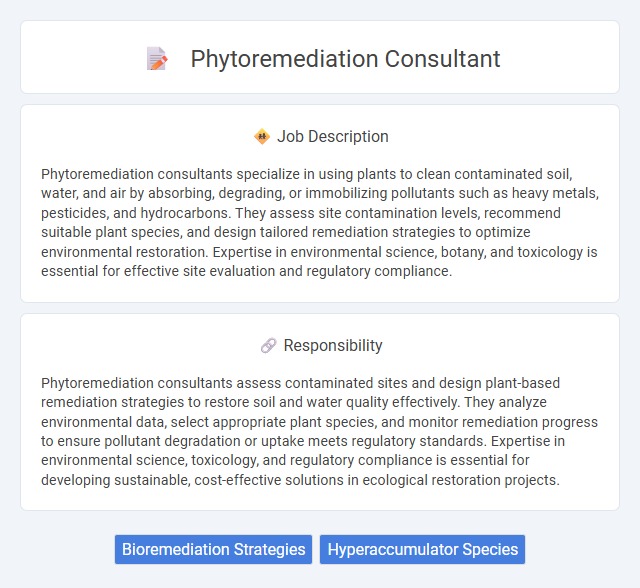
Phytoremediation consultants specialize in using plants to clean contaminated soil, water, and air by absorbing, degrading, or immobilizing pollutants such as heavy metals, pesticides, and hydrocarbons. They assess site contamination levels, recommend suitable plant species, and design tailored remediation strategies to optimize environmental restoration. Expertise in environmental science, botany, and toxicology is essential for effective site evaluation and regulatory compliance.
Individuals with a strong interest in environmental science and passion for sustainable solutions are likely well-suited for a phytoremediation consultant role. Those who can handle fieldwork, analyze soil and plant data, and communicate complex information effectively may find the job both fulfilling and manageable. People who prefer routine indoor work or lack resilience to environmental challenges might face difficulties adapting to this role.
Qualification
Phytoremediation consultant roles require expertise in environmental science, botany, and soil chemistry, often demanding a minimum of a bachelor's degree in these fields or related disciplines. Proven experience with contaminated site assessments, remediation project design, and knowledge of plant species effective in pollutant uptake are essential qualifications. Proficiency in environmental regulations and data analysis further strengthens a candidate's capability to develop effective phytoremediation strategies.
Responsibility
Phytoremediation consultants assess contaminated sites and design plant-based remediation strategies to restore soil and water quality effectively. They analyze environmental data, select appropriate plant species, and monitor remediation progress to ensure pollutant degradation or uptake meets regulatory standards. Expertise in environmental science, toxicology, and regulatory compliance is essential for developing sustainable, cost-effective solutions in ecological restoration projects.
Benefit
Phytoremediation consultants likely provide valuable expertise in using plants to remediate contaminated soils and water, potentially reducing the need for costly mechanical or chemical treatments. Their guidance could enhance the efficiency and sustainability of environmental cleanup projects, increasing the chances of successful pollutant removal. Employing their knowledge may also improve regulatory compliance and promote eco-friendly practices within affected industries.
Challenge
Challenges in a phytoremediation consultant job likely involve navigating complex environmental regulations and assessing the suitability of contaminated sites for specific plant-based remediation techniques. The consultant probably faces difficulties in predicting plant growth outcomes due to variable soil conditions and pollutant types. Limited data on long-term effectiveness and the slow pace of phytoremediation processes may also pose significant obstacles.
Career Advancement
Phytoremediation consultant careers offer significant opportunities for advancement through expertise in plant-based environmental cleanup technologies and regulatory compliance. Professionals in this field can progress to senior roles by acquiring advanced knowledge in soil and water remediation, project management, and environmental impact assessments. Mastery of emerging phytotechnologies and strong collaboration with environmental agencies further enhances career growth potential.
Key Terms
Bioremediation Strategies
Phytoremediation consultants specialize in designing and implementing bioremediation strategies that utilize plants to detoxify contaminated soil and water environments. Expertise in selecting appropriate plant species, soil amendments, and microbial interactions ensures effective remediation of heavy metals, hydrocarbons, and other pollutants. These professionals analyze site-specific conditions to optimize biodegradation and enhance pollutant uptake, contributing to sustainable environmental restoration.
Hyperaccumulator Species
Phytoremediation consultants specialize in identifying and utilizing hyperaccumulator species such as Pteris vittata and Alyssum murale, which absorb high levels of heavy metals from contaminated soils. These experts design and implement remediation strategies leveraging the unique physiological traits of hyperaccumulators to extract pollutants like arsenic, nickel, and cadmium efficiently. Their work supports environmental restoration projects by optimizing plant selection and growth conditions to remediate industrial sites, mining areas, and polluted landscapes.
 kuljobs.com
kuljobs.com